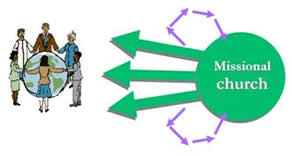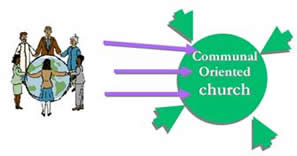In The Shaping of Things to Come, St Thomas’s Crookes is given as an example of a church that is shaped around its participation in God’s mission to the world. The basic level of the church consists of cells whose aim is to relate relevantly and redemptively with a particular segment of society. For example, one cell is involved in rock-climbing, another with the football crowd and a third with nightclubbers. To support this missional effort, congregations consisting of a few cells meet together weekly for teaching, sharing resources and worship. At a third level all congregations meet together occasionally for a time of celebration, worship and vision-casting1.
Current Misuse of “Missional”
“Missional” has become a popular term used to describe this kind of redemptive orientation towards the world. Churches like St. Thomas’s Crookes consider it their primary task to make the gospel relevant within a variety of settings outside of traditional church organization.
redemptive orientation towards the world. Churches like St. Thomas’s Crookes consider it their primary task to make the gospel relevant within a variety of settings outside of traditional church organization.  This concept contrasts the more communal oriented focus that endeavors to engage people within local expressions of church. Much has been written to help churches readjust their orientation and become missional.
This concept contrasts the more communal oriented focus that endeavors to engage people within local expressions of church. Much has been written to help churches readjust their orientation and become missional.
Unfortunately, the popularity of the term has resulted in two unhealthy extremes. Some authors use the word as nearly synonymous with “healthy” and thus contrast missional with “maintenance” churches that have little evangelistic drive2. This broadens the meaning to such an extent that it loses its original intent of highlighting an orientation towards gospel impact within the world. At the other extreme, some authors are so passionate about the need for God’s people to be redemptively relevant in the world that more traditional, communal expressions of church are referred to pejoratively as “institutional,” “traditional” or “attractional”3. A quick review of important missiological scholarship can help us maintain a clear and distinct definition of the term “missional” so that we can avoid these two extremes.
Christ and Culture
In his seminal work, "Christ and Culture," Richard Niebuhr4 explores five possible motifs to understand the ways Christ and culture relate to each other. The first motif sees culture as a human construct that must be rejected as evil and therefore the Christian goal is to become separate from the world. Churches with this view have an extractionist mentality with the goal of bringing people out of the world and into the church.
The second motif takes the opposite view and acknowledges a fundamental agreement between Christ and culture. This perspective sees culture as the object for the church: "man’s greatest task is to maintain his best culture"5. The weakness of this extreme view of culture is that it marginalizes God’s revealed truth. God’s word must be preserved as a prophetic message for transformation over and against culture.
The third motif is more inclusive of both culture and God’s revelation by not only seeing Christ in culture but also Christ above culture. That is, a spiritual Christianity can be expressed through cultural forms. This synthesis view of culture and Christ is strong when control over the context is maintained, but it is unable to adjust to outside pressures and is not transferable to new cultural settings. This approach is illustrated by the North American evangelical church subculture. It espouses values well in keeping with general social norms such as education and democracy and capitalism, and yet maintains a strong aversion towards changes, such as egalitarianism and postmodernism, that have occurred within the culture. The concern of such churches is not to engage culture, but to distance themselves out of a fear that they may lose control of basic Christian values and invite harmful cultural practices into the church. Yet at the same time, the response is not so much a radical rejection of culture as with the first motif, but rather an attempt to develop a Christianized subculture parallel to the secular society in areas of drama, music, sports and education. This motif also leads to an extractionist and inward focused mentality.
The fourth motif views the relationship of Christ and culture as an irresolvable paradox. This motif works from an assumption that there is a dualism of spiritual ideal and fallen human reality that cannot be reconciled or overcome. However, this view is ultimately not sustainable. Living with such tension pushes us on to grow and develop, but as humans, we do not like tension and seek to resolve it. Irresolvable tension is bound to lapse into complacency and a domestication of the gospel in order to ease the tension.
The fifth motif provides a solution to the weakness of the fourth motif by seeing Christ as the one who converts humanity within culture and society. This view looks at the world and trusts in the creating and transforming power of Christ to bring redemption. Thus the tension between good and evil is not equated to the tension between the ideal and culture, but a battle that occurs within culture. This battle is a result of the tension between the good resident within humankind because of the image of God (Gen 1:27), and the evil evident in the fall (Gen 3:7) by the turning away from God. These are the two paradoxical realities observed at both individual and communal levels. Therefore culture is best described as corrupted, that is, twisted, warped, misshapen or misdirected, rather than evil. Culture does not exist as an antithesis to good, but something created good but corrupted from its true purpose and thus requires redeeming. At the same time it must be recognized that culture is the medium through which humanity finds expression and thus it is only by redeeming humanity that culture can be saved.
Missiologists later developed the implications of the final motif to support the concept of the missional church. Communal, inward oriented churches tend to adopt the first motif (culture as evil) or the third motif (developing a parallel Christianized subculture).
Missio Dei: God’s Mission
D.J. Bosch provided a theological basis for the missional concept through his work on missio Dei in Transforming Mission6. Missio Dei is a move to a theocentric view of missions rather than considering it equivalent to the expansion of the church. That is, rather than considering church planting or church growth as the fulfillment of the Great Commission, the focus shifts to the recognition that God is working to bring transformation in the world. Missions as a human endeavor then becomes a partnership in the greater story of God’s redemptive movement in the world. This places the locus of God’s action in the world, rather than in the church. A missional orientation seeks to be involved with God in the world rather than adopting an inward mentality that draws people from the world into local expressions of church life.
“Hermeneutic of the Gospel”
In The Gospel in a Pluralist Society, Lesslie Newbigin asks how the church can “truly represent the reign of God in the world in the way Jesus did” and responds with a poignant description of the missional church. He states that church’s purpose is not fulfilled through simply responding to the “aspirations” of people in the world, nor is it by “portraying the Church in the style of a commercial firm using modern techniques of promotion to attract members.” Instead “the only hermeneutic of the gospel is a congregation of men and women who believe it and live by it.” This congregation “will be a community that does not live for itself but is deeply involved in the concerns of neighborhood. It will be the church for the specific place where it lives, not the church for those who wish to be members of it – or, rather, it will be for them insofar as they are willing to be for the wider community.” Moreover this church will be a “royal priesthood” within the world continuing the work of Jesus by “reconciling people to God.” This priesthood occurs not within “the walls of the Church but in the daily business of the world”7.
“Missional Congregations”
Darrell L. Guder builds on Bosch and Newbigin to contrast a “producer-consumer” model of church with a church as “a body of people sent on a mission.” This mission is centered on the “reign of God as [the church’s] missional perspective.” It is not a project that the church is to work on, but a gift of God that is lived out by the church in the world. Thus evangelism moves “from an act of recruiting or co-opting those outside the church, to an invitation of companionship.” That is, the essential purpose of the church moves from a project or a formula for church growth to the development of transforming relationships within the wider community. Along with the experience of the kingdom of God within the body of Christ, the church “represents to the world the divine reign’s character, claims, demands, and gracious gifts as its agent and instrument”8.
With this understanding serving as the basic definition of the missional concept we can move on in the next article to contrast some ways the missional church concept has been misrepresented.
- _______________
- (1) Michael Frost & Alan Hirsch, The Shaping of Things to Come: Innovation and Mission for the 21st-Century Church (Peabody: Henderson, 2006), 53.
- (2) Milfred Minatrea, Shaped by God’s Heart: The Passion and Practices of Missional Churches (San Francisco: Jossey-Bass, 2004), 5.
- (3) Frost & Hirsch, The Shaping of Things to Come, 16, 19.
- (4) This section is a summary of a review of Richard H. Niebuhr’s book Christ and Culture (New York: Harper & Row, 1951) by Mark Naylor in The Intercultural Communication of the Gospel (Unpublished, 2003), pp. 35-38. Direct quotes from Niebuhr are footnoted.
- (5) Niebuhr, Christ and Culture, 102.
- (6) D.J. Bosch, Transforming Mission. Paradigm shifts in theology of mission (Maryknoll: Orbis, 1991), e.g., 519.
(7) L. Newbigin, The Gospel in a Pluralist Society. (Grand Rapids: Eerdmans, 1989), see pp. 226-230.
- (8) Darrell L. Guder, Missional Church: A vision for the sending of the Church in North America (Grand Rapids: Eerdmans, 1998), see pp. 85-102.
